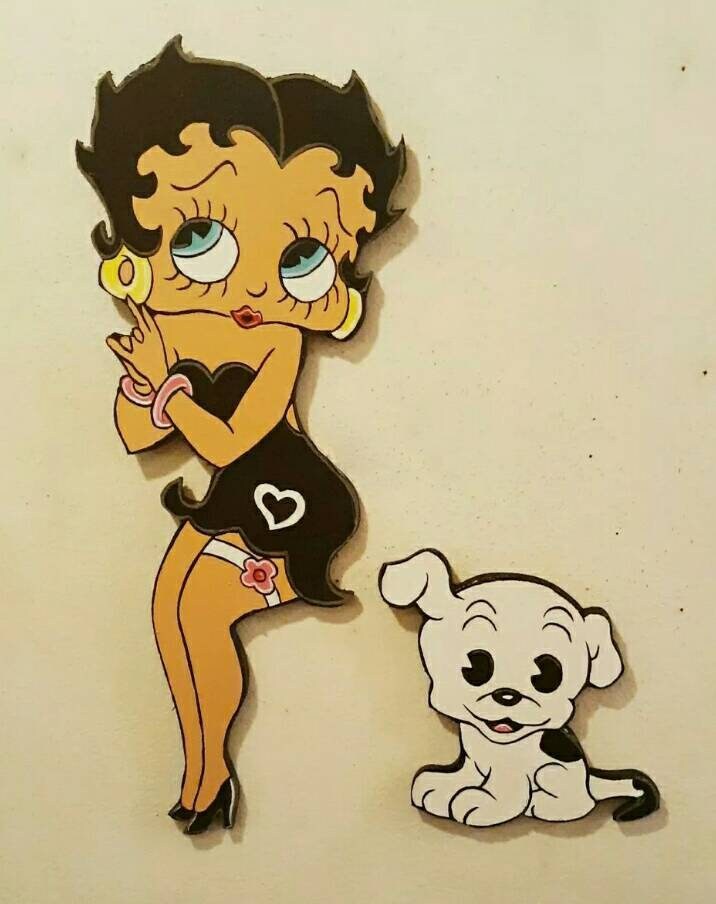Table Of Content
- Baby Esther Lee Jones’ Tragic Anonymity Despite Being The Original Betty Boop
- Guess Originals Gets Animated With New Betty Boop Capsule Collection
- Designer Betty Boop Jean Outfit 20oz Tumbler Wrap, Black Betty Boop, Coach Design PNG, 20oz Skinny Tumbler
- Red Bag with Betty B. 20oz sublimated Tumbler Neoprene Lunch Tote Gold and Black Flatware Set
- optional screen reader
- Peter Benjaminson *77 Traces History of Beloved Icon Betty Boop

In the film, she was depicted with red hair as opposed to her typical black hair. The collection took inspiration from Betty Boop’s flapper look and the brand’s casual-wear aesthetic. Betty Boop appeared in two television specials, “The Romance of Betty Boop” (1984) and “The Betty Boop Movie Mystery” (1989), as well as cameo appearances in television commercials. And while television revivals were conceived, nothing materialized to the degree originally planned. Betty Boop made her first appearance on August 9, 1930 in the cartoon Dizzy Dishes, the sixth installment in Fleischer’s Talkartoon series.
Baby Esther Lee Jones’ Tragic Anonymity Despite Being The Original Betty Boop
From its home in California, Disney was laying the groundwork for the idyllic, fantastical fairy tales that would soon dominate its oeuvre. In New York, meanwhile, Fleischer created a grungy, often dangerous urban world for its characters to navigate. Betty appeared in the first "Color Classic" cartoon Poor Cinderella, her only theatrical color appearance in 1934.
Guess Originals Gets Animated With New Betty Boop Capsule Collection
The enduring image of Betty is a flapper in a strapless minidress, with a garter peeking out above her knee and large hoop earrings in her ears. Beneath that iconic look, however, is a more complex story of aesthetic transformation, from what Heather Hendershot, a media historian at MIT, describes as a “flapper-secretary-adventurer” in the early 1930s to a “middle-class homemaker” by the end of the decade. Betty’s appearance continues to evolve today, with the character donning ripped jeans, joggers and sneakers, and overalls in merchandise and on social media.
Designer Betty Boop Jean Outfit 20oz Tumbler Wrap, Black Betty Boop, Coach Design PNG, 20oz Skinny Tumbler
While an outgrowth of Jazz “scat singing,” testimony revealed that Miss Kane had witnessed a black performer, “Baby Esther” using a similar characterization in an act at the famous Cotton Club nightclub in Harlem some years earlier. An early test sound film was discovered of Baby Esther performing in this style, disproving Miss Kane’s claims. Betty's FriendsIn 1932 Betty took over as the Fleischer star, and Bimbo was relegated to the role of her companion. He didn't seem to mind, even when she stopped being a dog and became human. Other regular co-stars included Ko-Ko the clown, who had been retired for some years from his previous cartoon series, and Pudgy, her faithful puppy companion (created by Myron Waldman).
As History reports, "the press had a field day with the concept of a performer attempting to protect her popular 'boops.'" The Fleischers were not impressed and fought back. Besides testimony from the women who had voiced Boop for the cartoons, other performers testified as well. Fleischer Studios was on the cutting edge of sound as well as animation, and their Betty cartoons featured many leading vocalists and musicians of the time, including Ethel Merman, Rudy Vallee, and Don Redman. Fleischer particularly tapped in to jazz, and Betty performed alongside jazz legends like Cab Calloway and Louis Armstrong. The New York Times called her “the most menacing of the baby-talk ladies”—a reference to a vaudeville phenomenon also used by performers like Fanny Brice and Irene Franklin. Two years before Betty Boop’s debut, Kane had skyrocketed to fame with the song “That’s My Weakness Now,” which used the phrase “boop-boop-a-doop” as shorthand for sex.
Lancôme Mascara Ads Feature Betty Boop - The New York Times
Lancôme Mascara Ads Feature Betty Boop.
Posted: Mon, 12 Nov 2012 08:00:00 GMT [source]
Her popularity was drawn largely from adult audiences, and the cartoons, while seemingly surreal, contained many sexual and psychological elements, particularly in the 1932 "Talkartoon" Minnie the Moocher (1932), featuring Cab Calloway and his orchestra. As new color cartoons made specifically for television began to appear in the 1960s, the original black-and-white cartoons were retired. Boop's film career had a revival with the release of The Betty Boop Scandals of 1974, becoming a part of the post-1960s counterculture. NTA attempted to capitalize on this with a new syndication package, but because no market existed for cartoons in black and white, they sent them to South Korea, where the cartoons were hand-traced frame-by-frame in color, resulting in the degradation of the animation quality and timing.

Due to a combination of policies affected by the Production Code and also changes in the content of Paramount’s films also affected Betty’s later appearances. While her later cartoons were more slick and consistently produced, they relied heavily on self-consciously cute and moralistic preaching, making Betty more of a “good citizen” maiden aunt spinster separated from any references to sexuality, and innocent girlishness. Oddly, Betty became a secondary character in her own cartoons, which began to center on the adventures of her pet dog, Pudgy, and the eccentric inventor, Grampy, who bore an interesting resemblance to Koko the Clown. Though the flapper age was over by the time Betty Boop took to the screen, she was beloved by Depression-era audiences. “The public embraced her because [she] reminded them of the carefree days of the 1920s,” says Pointer.
Her 1920s-speakeasy vibe begat the Old Hollywood look of the 1940s, which begat 1950s red-lips-and-fingertips and cat-eye flicks, which begat the glamour revival of the 1980s, and, in the new millennium, Bambi-lashes, felt-tip liquid liners, and, yes, bright red lipsticks. Just check out this smattering of trendsetters who have bitten Betty Boop’s style for proof that no one—and we mean no one—will ever take her boop-oop-a-doop away. Very little is known about Esther Jones’s life, or her death, after the infamous Betty Boop trial. Many photos alleged to be of “Baby Esther” were actually of other performers named Esther, and “Baby Esther” is most commonly confused with jazz singer Little Esther Phillips. Wikimedia CommonsThough she was the original Betty Boop, Black vaudeville singer “Baby” Esther Lee Jones received no credit or compensation for inspiring the iconic cartoon character. And as the cartoon became wildly successful, Kane felt slighted by the “Boop, Boop-A-Doop” — and without a shred of self-awareness or irony, proceeded to file a $250,000 lawsuit against Max Fleischer, Betty Boop’s creator, just two years after the cartoon vixen debuted on the big screen.
Peter Benjaminson *77 Traces History of Beloved Icon Betty Boop
The Musical, she’s stepping from her cartoon world into life as we live it today. Kane’s delivery—including her signature “boop-boop-a-doop”—was “a theatrical staple going back years,” says Pointer. Like the vaudeville performers that preceded her, Kane used her little-girl voice to deliver lyrics that would have been shocking in the mouth of another singer.
After Betty’s image was tamed by the onset of the Production Code in 1934, her popularity declined and the series was discontinued in 1939. Her floppy poodle ears became hoop earrings, and her black poodle nose became a girl’s button-like nose. Betty appeared in ten cartoons as a supporting character, a flapper girl with more heart than brains. In individual cartoons she was called “Nancy Lee” and “Nan McGrew”, usually served as a girlfriend to studio star Bimbo. In April 1934, Helen Kane, whose popularity had waned since her debut in 1929, filed suit against Max Fleischer, Fleischer Studios and Paramount Pictures for $250,000.
Even though she was given a more modest makeover after the passage of the Hays Code in 1934, she stayed popular until she was discontinued in 1939. The dog-turned-doll-like heroine has lived on through syndication and merchandising since television’s early days. Audiences would have recognized the send-up of Kane, now a Paramount star. But so did Kane herself—and when she experienced economic hardship due to a layoff, she took legal action against the animation studio. She sought $250,000 in damages and no further showings of Betty Boop cartoons—and claimed that phrases like “boop-boop-a-doop, boop-boopa doop, or boop-boopa-do, or boop-a-doop or similar combinations of such sounds or simply boop alone” were her own—part of what she called her “baby vamp” act.
To create the capsule, Guess Originals worked with Fleischer Studios, Inc., the American animation studio that created Betty Boop. Writer Bob Martin also admits the musical bears some resemblance, coincidentally, to Barbie. Madonna flirted with the look a billion times, but she even had her own Boop-ish cartoon drawn for the opener of the her 1987 movie, “Who’s That Girl”.
And as the most unique human woman cartoon character of her day, she became a fan favorite. In the cartoon “Hot Dog,” released on March 29, 1930, in which Bimbo starred and in which Betty did not appear, Bimbo was shown out driving and trying to pick up women walking on the sidewalk. At the time, “hot dog” was slang for “attractive woman.” Appropriately enough, considering this quest of Bimbo’s, his name had two different meanings at the beginning of his cartoon career. When he was first dubbed “Bimbo,” that word meant a tough guy, or a criminal. Soon after Bimbo’s character began appearing on the screen, however, “bimbo” came to mean a promiscuous female. Whether or not this shift in meaning was partly prodded by Bimbo’s relentless on-screen pursuits, it underscored his interest in women.

No comments:
Post a Comment